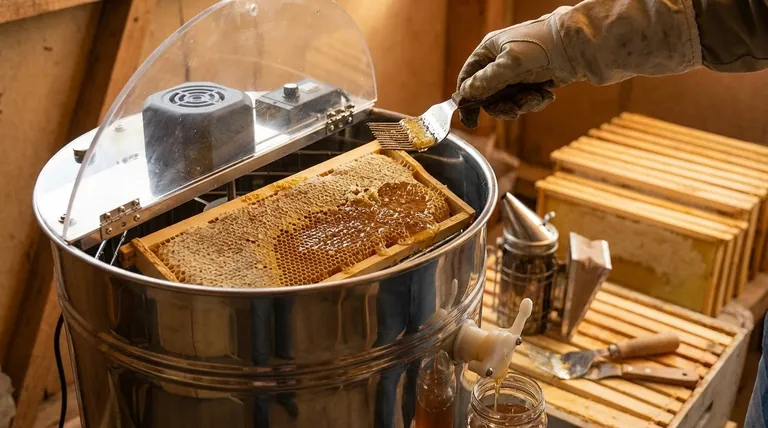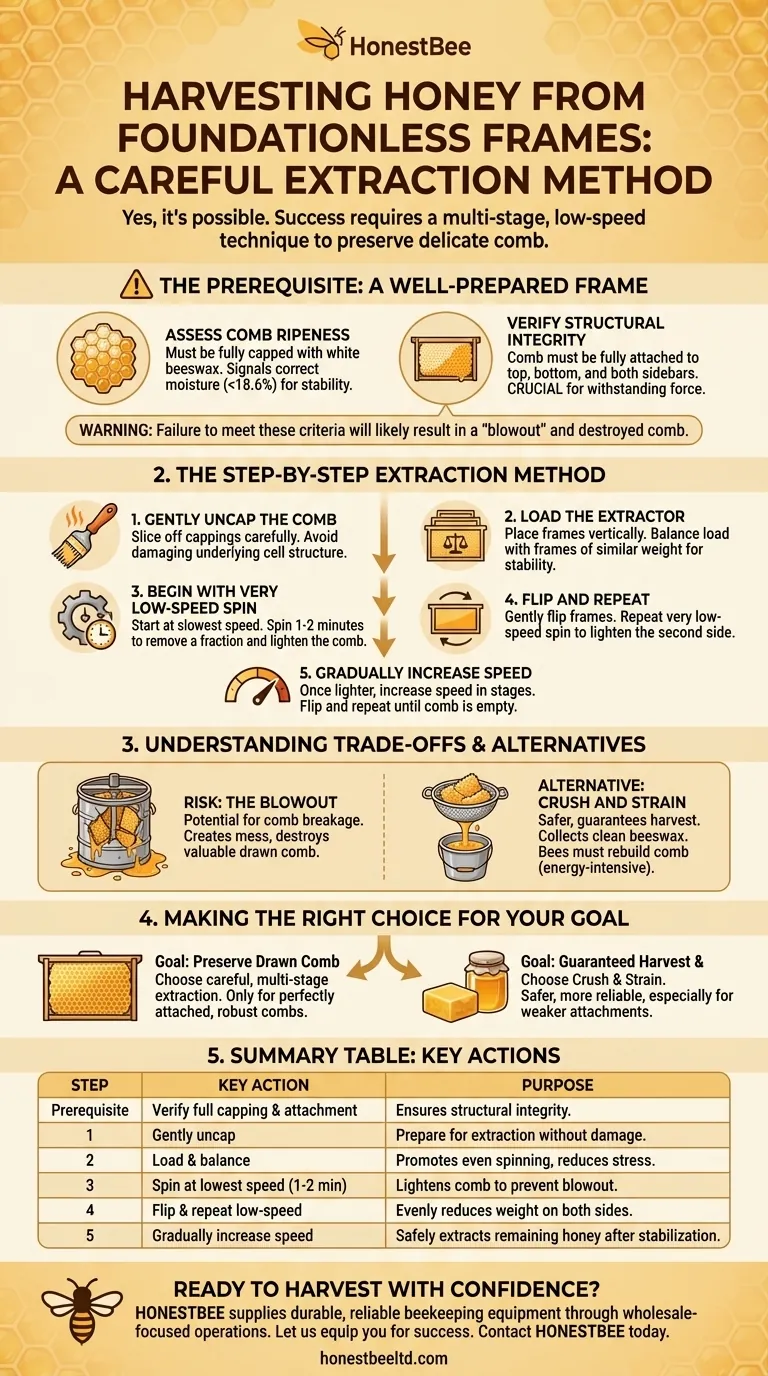Yes, it is possible to harvest honey from foundationless frames using a standard centrifugal extractor, but it requires a specific, careful technique to prevent the delicate comb from disintegrating under the force. The success of this method hinges on the structural integrity of the comb and a very gradual increase in extraction speed.
The core challenge with foundationless frames is their lack of internal support. To extract successfully, you must use a multi-stage, low-speed spinning process that lightens the comb gradually, preventing the weight of the honey from tearing the wax apart.

The Prerequisite: A Well-Prepared Frame
Before you even consider using an extractor, your foundationless frames must meet two critical criteria. Attempting to extract without verifying these will almost certainly result in a "blowout," where the comb shatters inside your extractor.
Assess Comb Ripeness
Your first check is to ensure the honey is ready. Look for frames where the honeycomb is fully capped with a layer of white beeswax. This is the bees' signal that the honey has been dehydrated to the correct moisture content (under 18.6%) and is stable for long-term storage.
Verify Structural Integrity
This is the most crucial step for foundationless frames. The comb must be fully attached to all four sides of the wooden frame—the top bar, bottom bar, and both sidebars. This complete attachment creates the structural tension needed to withstand even minimal centrifugal force. Partially attached combs will fail.
The Step-by-Step Extraction Method
If your frames meet the prerequisites, you can proceed with extraction. The key is to be slow and methodical.
Step 1: Gently Uncap the Comb
Using a heated knife or an uncapping fork, carefully slice off the top layer of wax cappings from the cells. Work gently to avoid damaging the underlying cell structure.
Step 2: Load the Extractor
Place the uncapped frames vertically into the extractor baskets. For a tangential extractor (where one side faces out), try to balance the load with frames of similar weight on opposite sides.
Step 3: Begin with a Very Low-Speed Spin
Start the extractor at its absolute slowest speed. The goal here is not to extract all the honey, but merely to remove a fraction of it from the outward-facing side of the comb. Spin for just a minute or two. This initial step is critical for lightening the frame.
Step 4: Flip and Repeat
Stop the extractor, gently flip the frames so the other side faces out, and repeat the process at that same very low speed. You are now removing some of the honey from the second side, further reducing the total weight and stress on the comb's center.
Step 5: Gradually Increase Speed
Now that the frames are significantly lighter, you can return them to their original orientation and gradually increase the speed. Continue to spin for a few minutes, then flip and extract the other side at this slightly higher speed until the comb is empty.
Understanding the Trade-offs and Alternatives
Using an extractor on foundationless frames is an calculated risk. Understanding the potential downsides and alternatives is key to making the right decision for your operation.
The Risk of a Blowout
Even with care, there is always a risk the comb will break apart. A "blowout" creates a significant mess of honey and wax inside your extractor and destroys the valuable drawn comb that your bees worked so hard to build.
The Alternative: Crush and Strain
For many small-scale or hobbyist beekeepers, the crush and strain method is a safer and more practical alternative. This involves cutting the comb out of the frame, crushing it to break open all the honey cells, and letting it drain through a sieve or filter.
This method guarantees you won't damage your extractor and allows you to harvest the clean, valuable beeswax as a secondary product. The primary downside is that the bees must completely rebuild the comb from scratch, which requires significant energy and resources.
Making the Right Choice for Your Goal
Ultimately, the method you choose depends on what resource you value most: the drawn comb or the beeswax.
- If your primary focus is preserving the drawn comb for reuse: A careful, multi-stage extraction is a viable option, but only for perfectly attached, robust combs.
- If your primary focus is a guaranteed harvest and collecting beeswax: The crush and strain method is the safer, more reliable choice and is especially suited for frames with weaker attachments.
Choose the method that aligns best with your goals and the specific condition of your frames.
Summary Table:
| Step | Key Action | Purpose |
|---|---|---|
| Prerequisite | Verify comb is fully capped and attached to all sides of the frame. | Ensures structural integrity before spinning. |
| Step 1 | Gently uncap the comb. | Prepare honey cells for extraction without damaging the wax. |
| Step 2 | Load frames into the extractor, balancing the load. | Promotes even spinning and reduces stress on the equipment. |
| Step 3 | Spin at the lowest speed for 1-2 minutes. | Lightens the comb gradually to prevent a blowout. |
| Step 4 | Flip frames and repeat the low-speed spin. | Evenly reduces weight on both sides of the delicate comb. |
| Step 5 | Gradually increase speed in stages until comb is empty. | Safely extracts remaining honey after the comb is stabilized. |
Ready to Harvest with Confidence?
Whether you're a commercial apiary or a beekeeping equipment distributor, having the right tools is essential for efficient and safe honey extraction. HONESTBEE supplies durable, reliable beekeeping supplies and equipment through wholesale-focused operations.
Let us equip you for success. Contact HONESTBEE today to discuss your needs and ensure your next harvest is your best one yet.
Visual Guide

Related Products
- electric honey extractor honey centrifuge 3 frame honey extractor stainless steel honey frame extractor
- HONESTBEE 6 Frame Three Use Electric Honey Extractor for Beekeeping
- HONESTBEE 72 Frame Industrial Electric Honey Extractor for Beekeeping
- 6 Frame Manual Stainless Steel Honey Extractor Beekeeping Equipment
- 8-Frame Electric Self-Reversing Honey Extractor Spinner for Commercial Honey Extraction Equipment
People Also Ask
- What are the main processes involved in honey processing? From Hive to Jar, A Complete Guide
- How long does honey take to extract? A Guide to Streamlining Your Harvest Process
- What are the steps for honey extraction using a centrifuge? A Guide to Efficient, Comb-Preserving Harvests
- What are the two main types of honey extractors? Choose Between Tangential and Radial for Your Apiary
- How do automatic honey extractors function? Achieve High-Efficiency Honey Harvesting



















